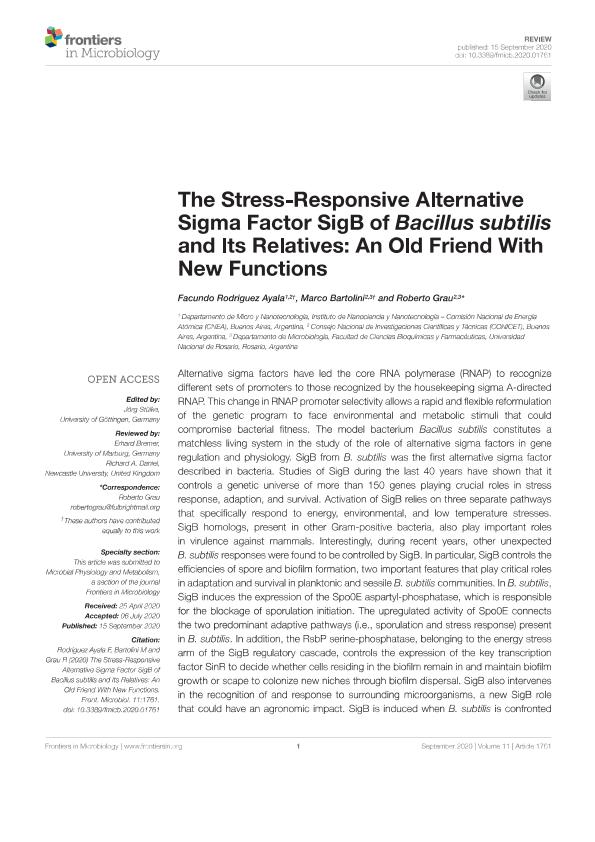Mostrar el registro sencillo del ítem
dc.contributor.author
RodrIguez Ayala, Facundo
dc.contributor.author
Grau, Roberto Ricardo

dc.contributor.author
Bartolini, Marco

dc.date.available
2022-10-24T15:59:05Z
dc.date.issued
2020-09
dc.identifier.citation
RodrIguez Ayala, Facundo; Grau, Roberto Ricardo; Bartolini, Marco; The stress-responsive alternative sigma factor of Bacillus subtilis: An old friend with new functions; Frontiers Media; Frontiers in Microbiology; 11; 1761; 9-2020; 1-20
dc.identifier.issn
1664-302x
dc.identifier.uri
http://hdl.handle.net/11336/174595
dc.description.abstract
Alternative sigma factors have led the core RNA polymerase (RNAP) to recognize different sets of promoters to those recognized by the housekeeping sigma A-directed RNAP. This change in RNAP promoter selectivity allows a rapid and flexible reformulation of the genetic program to face environmental and metabolic stimuli that could compromise bacterial fitness. The model bacterium Bacillus subtilis constitutes a matchless living system in the study of the role of alternative sigma factors in gene regulation and physiology. SigB from B. subtilis was the first alternative sigma factor described in bacteria. Studies of SigB during the last 40 years have shown that it controls a genetic universe of more than 150 genes playing crucial roles in stress response, adaption, and survival. Activation of SigB relies on three separate pathways that specifically respond to energy, environmental, and low temperature stresses. SigB homologs, present in other Gram-positive bacteria, also play important roles in virulence against mammals. Interestingly, during recent years, other unexpected B. subtilis responses were found to be controlled by SigB. In particular, SigB controls the efficiencies of spore and biofilm formation, two important features that play critical roles in adaptation and survival in planktonic and sessile B. subtilis communities. In B. subtilis, SigB induces the expression of the Spo0E aspartyl-phosphatase, which is responsible for the blockage of sporulation initiation. The upregulated activity of Spo0E connects the two predominant adaptive pathways (i.e., sporulation and stress response) present in B. subtilis. In addition, the RsbP serine-phosphatase, belonging to the energy stress arm of the SigB regulatory cascade, controls the expression of the key transcription factor SinR to decide whether cells residing in the biofilm remain in and maintain biofilm growth or scape to colonize new niches through biofilm dispersal. SigB also intervenes in the recognition of and response to surrounding microorganisms, a new SigB role that could have an agronomic impact. SigB is induced when B. subtilis is confronted with phytopathogenic fungi (e.g., Fusarium verticillioides) and halts fungal growth to the benefit of plant growth. In this article, we update and review literature on the different regulatory networks that control the activation of SigB and the new roles that have been described the recent years.
dc.format
application/pdf
dc.language.iso
eng
dc.publisher
Frontiers Media

dc.rights
info:eu-repo/semantics/openAccess
dc.rights.uri
https://creativecommons.org/licenses/by/2.5/ar/
dc.subject
ALTERNATIVE SIGMA FACTORS
dc.subject
BACILLUS SUBTILIS
dc.subject
BIOCONTROL
dc.subject
BIOFILM FITNESS
dc.subject
GENERAL STRESS RESPONSE
dc.subject
SIGB
dc.subject
SPORULATION
dc.subject.classification
Bioquímica y Biología Molecular

dc.subject.classification
Ciencias Biológicas

dc.subject.classification
CIENCIAS NATURALES Y EXACTAS

dc.title
The stress-responsive alternative sigma factor of Bacillus subtilis: An old friend with new functions
dc.type
info:eu-repo/semantics/article
dc.type
info:ar-repo/semantics/artículo
dc.type
info:eu-repo/semantics/publishedVersion
dc.date.updated
2022-09-19T15:06:35Z
dc.journal.volume
11
dc.journal.number
1761
dc.journal.pagination
1-20
dc.journal.pais
Suiza

dc.journal.ciudad
Lausana
dc.description.fil
Fil: RodrIguez Ayala, Facundo. Comisión Nacional de Energía Atómica. Unidad Ejecutora Instituto de Nanociencia y Nanotecnología. - Consejo Nacional de Investigaciones Científicas y Técnicas. Oficina de Coordinación Administrativa Ciudad Universitaria. Unidad Ejecutora Instituto de Nanociencia y Nanotecnología; Argentina. Comisión Nacional de Energía Atómica. Gerencia de Área de Investigación y Aplicaciones no Nucleares. Gerencia de Desarrollo Tecnológico y Proyectos Especiales. Departamento de Micro y Nanotecnología; Argentina
dc.description.fil
Fil: Grau, Roberto Ricardo. Consejo Nacional de Investigaciones Científicas y Técnicas. Centro Científico Tecnológico Conicet - Rosario; Argentina. Universidad Nacional de Rosario. Facultad de Ciencias Bioquímicas y Farmacéuticas. Departamento de Microbiología; Argentina
dc.description.fil
Fil: Bartolini, Marco. Consejo Nacional de Investigaciones Científicas y Técnicas. Centro Científico Tecnológico Conicet - Rosario; Argentina. Universidad Nacional de Rosario. Facultad de Ciencias Bioquímicas y Farmacéuticas. Departamento de Microbiología; Argentina
dc.journal.title
Frontiers in Microbiology
dc.relation.alternativeid
info:eu-repo/semantics/altIdentifier/doi/https://doi.org/10.3389/fmicb.2020.01761
dc.relation.alternativeid
info:eu-repo/semantics/altIdentifier/url/https://www.frontiersin.org/articles/10.3389/fmicb.2020.01761/full
Archivos asociados
